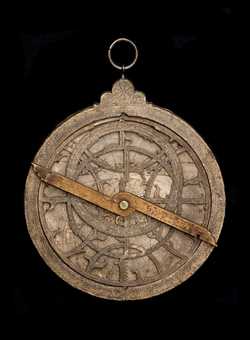| Date | 1609 |
| Maker | Johann Krabbe |
| Place | Germany |
| Material | Wood |
| Inventory no. | 44745 |
| Acquisition | Presented by Lewis Evans in 1924 |
The German mathematician Johann Krabbe (1553-?1625) engraved his astrolabe in 1583 as a series of printing plates, from which multiple copies could be made as paper sheets, to be mounted on card or wood. The 16th-century revival of interest in the astrolabe in Europe followed the invention of printing and included a flourishing tradition of making them of printed paper (for example, inventory nos. 34268 and 49296). By definition however these instruments were ephemeral and fragile, and have survived in misleadingly small numbers.
Krabbe’s plate was over twenty years old when he updated it to accompany his book Newes Astrolabium in 1609. Since his appointment as geometer to the princely Duke of Brunswick in 1585 he had been based at Wolfenbüttel. So he has added to his original engraved plate the coat of arms of his patron and his own new details, but without erasing his original signature dated 1583 at Munden (hence there are two versions of his signature immediately next to each other). The new date ‘16 / 09’ falls on either side of the central hole, and in this well-used example has been partly worn away by the turning of the central washer.
These printed sheets were included with his 1609 book so that the purchaser could cut them out and mount them on wood or pasteboard to form the working instrument. This is what has happened in this case. A new edition of Krabbe’s book appeared in 1625, with the same 1583/1609 plates once more supplied with it, indicating over how long a period such printing plates might remain in use. The Museum’s collection also contains the 1625 edition of the book, with the paper sheets intact at the end.
View all
images for this astrolabe
View
detailed provenance for this astrolabe
Mater
The mater and limb are of two pieces, nailed construction. Both the front and edge of the limb are covered by the paper paste-down.. Scales on the limb: equal hours scale; equal hours scale. More informationBack
Centered below the shadow square there is a drawn compass indicating north.. The back contains 6 scales of the following types: Altitude; Zodiacal signs; Calendar; Shadow square; Unequal hours. The back is inscribed: with a dedication marked as HENRI. IVLI. D. G. P. E. H. E. / D. BRVNSVIC. E. LVNEB. ETC. (Henricus Julius, Bishop of Halberstadt, Duke of Brunswick and Lüneburg, etc.). This inscription encircles the Duke's coat of arms.. with a maker's signature marked as IOHANN[IS] KRABBEN. ASTROLABIVM. Cum Gra. et Priuile. Cæsar. Maij: WOLFFERBŸTÆ (Astrolabe by Johannes Krabbe of Wolfenbüttel. With the Grace and Privilege of the Great Emperor). with a maker's signature marked as FACIEBAT JOHANNES KRABBE MVNDENSIS. ANNO M.D. LXXXIII (Johannes Krabbe of Munden made this in the year 1583). with a motto marked as Si Deus pronobis quis contra nos. 16 [09] (If God [is] for us who [is] against us. 1609). Presumably the Duke of Brunswick's motto, accompanying the coat of arms. More informationRete, Nut & Bolt
The rete contains 0 stars. The zodiac on the rete is labelled: ARIES ♈ , TAVR9 ♉ , GEMINI ♊ , CANC ♋ , LEO ♌ , VIRGO ♍ , LIBRA ♎ , SCORPIVS ♏ , SAGITTARIVS ♐ , CAPRICORNV9 ♑ , AQVARIVS ♒ , PIS ♓ .The rete is attached using a nut & bolt. The brass bolt is still present; the nut and any washer has since been lost.. More information
Rules & Alidades
| Type | Details |
|---|---|
| Rule | Double-ended, counter-changed. This rule is most
likely missing a pair of sighting vanes.. |


